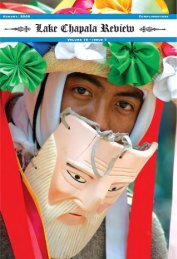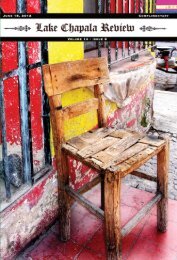Volume 10 - Issue 1, February 15, 2008 - Lake Chapala Review
Volume 10 - Issue 1, February 15, 2008 - Lake Chapala Review
Volume 10 - Issue 1, February 15, 2008 - Lake Chapala Review
You also want an ePaper? Increase the reach of your titles
YUMPU automatically turns print PDFs into web optimized ePapers that Google loves.
Page 48 <strong>Lake</strong> <strong>Chapala</strong> <strong>Review</strong><br />
<strong>February</strong> <strong>2008</strong><br />
Maestros del Arte<br />
by Marianne Carlson Art-Hippocrates to Oscar Wilde<br />
If Hippocrates or Oscar Wilde said to you, “Hey, if you’re<br />
shopping for unusual and unique art, be sure you go to<br />
Galería Maestros del Arte,” would you listen to them?<br />
Well, I know I might‑would‑well, probably would‑should!<br />
Galería Maestros del Arte has moved (yet again) to join<br />
Galería La Puerta in bringing to Ajijic the most eclectic<br />
collection of art to be found at <strong>Lake</strong>side. All this can be<br />
found at Colon #13, Ajijic.<br />
Here is what a few famous people from history (and<br />
one friend) had to say about art. Hopefully, they will<br />
entice you into our galleries, to explore and learn more<br />
about the vast array of art available in Mexico, and more<br />
particularly, here at <strong>Lake</strong>side.<br />
“The color! The color!” A friend visiting me for the first<br />
time..<br />
She was referring to the Mexican art in my home<br />
that surrounds my everyday life.<br />
“Art is the most intense mode of individualism that the<br />
world has known.” Oscar Wilde<br />
The artisan (he or she) has always been an<br />
important factor in the equation of their society<br />
and culture. He earned for himself a certain status<br />
and a responsible position in society. He made<br />
things mainly for the use of the people around him<br />
and not so much for sale in a distant marketplace.<br />
He was an heir to the people’s traditions and he<br />
wove them into his craft, making it into an art.<br />
“Art hath an enemy called ignorance.” Ben Johnson<br />
I don’t think I would be inaccurate to assume that<br />
most of Mexico’s visitors do not know very much<br />
about folk art. Most tourists do not realize that<br />
pottery they purchased may have been made in<br />
the same family for generations. Neither do they<br />
know it can take a month to weave a rebozo.<br />
And it’s almost certain they are unaware that<br />
the woman who wove the huipile they believe<br />
is priced “too high” may give up weaving these<br />
indigenous garments to weave placemats for<br />
tourists because she cannot get a “fair” price for<br />
her work.<br />
“Art is long, life is short.” Hippocrates<br />
Craftsmanship has no boundaries and systems of<br />
government, it outlives republics and empires: the<br />
pottery, basketwork, and weaving have survived<br />
Mayan priests, Aztec warriors, and Mexican<br />
presidents. They will also survive American<br />
tourists. Craftsmen have no country; they are from<br />
their village. What is more, they are from their<br />
neighborhood and their family. The craftsman<br />
does not define himself in terms of nationality or<br />
religion. His workday is not ruled by a rigid time<br />
schedule but by a rhythm linked more to his body<br />
and sensibility than to the abstract necessities of<br />
production. As the artisan works he may talk with<br />
others and sometimes sing.<br />
“Art is a deliberate recreation of a new and special reality<br />
that grows from your response to life. It cannot be copied;<br />
it must be created.” Anonymous




